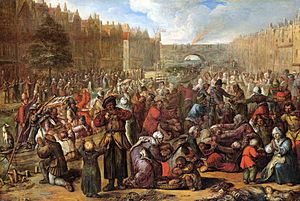Eighty Years' War facts for kids
Quick facts for kids Eighty Years' War |
|||||||
|---|---|---|---|---|---|---|---|
 Relief of Leiden after the siege, 1574 |
|||||||
|
|||||||
| Belligerents | |||||||
| Commanders and leaders | |||||||
| Casualties and losses | |||||||
| ~100,000 Dutch killed (1568–1609) |
Unknown | ||||||
The Eighty Years' War (also known as the Dutch War of Independence) was a very long conflict that lasted from 1568 to 1648. It was a fight for freedom by the Seventeen Provinces against the rule of Philip II of Spain. These provinces are now parts of the Netherlands, Belgium, Luxembourg, and a region in France.
At first, Philip II sent his armies and took back control of many areas. But the northern provinces kept fighting under the leadership of William the Silent. They eventually pushed out the Spanish armies. In 1581, they formed their own independent country, called the Republic of the Seven United Netherlands.
The war continued in other places, even though the new republic was safe. This included battles overseas as the Dutch started building their own colonial empire.
After a 12-year break, the fighting started again around 1619. This part of the war happened at the same time as the Thirty Years' War in Europe. The Eighty Years' War finally ended in 1648 with the Peace of Münster. This treaty officially recognized the Dutch Republic as a free and independent country. The Peace of Münster also marked the beginning of the Dutch Golden Age, a time when the Netherlands became very rich and powerful.
Contents
Why the War Started
In the years before the war, people in the Dutch provinces were unhappy with the Habsburg rulers. The Habsburgs were a powerful European family, and Philip II of Spain was their ruler.
Heavy Taxes and Slow Decisions
One big reason for the unhappiness was the high taxes people had to pay. Also, the Habsburg empire was so large that it was hard for the government to make quick decisions or offer support. The Dutch provinces were often criticized for acting on their own. But it took at least four weeks to get an answer from the king!
Spanish Soldiers and Unrest
The presence of Spanish soldiers also caused a lot of trouble. These troops, led by the Duke of Alba, were sent to keep order. But their presence only made people more upset.
Religious Differences
Spain wanted everyone to be part of the Catholic Church. They used the Inquisition, a strict religious court, to make sure people followed Catholic rules.
However, a movement called the Reformation was spreading. It led to new Christian groups called Protestants. Many people in the Seventeen Provinces became Protestants, including followers of Martin Luther, Menno Simons, and John Calvin.
This growth of Protestantism led to the Beeldenstorm in 1566. This "Iconoclastic Fury" was a time when many churches in northern Europe had their Catholic statues and decorations removed or destroyed. These religious differences added to the tension and helped cause the war.
Images for kids
See also
 In Spanish: Guerra de los Ochenta Años para niños
In Spanish: Guerra de los Ochenta Años para niños


